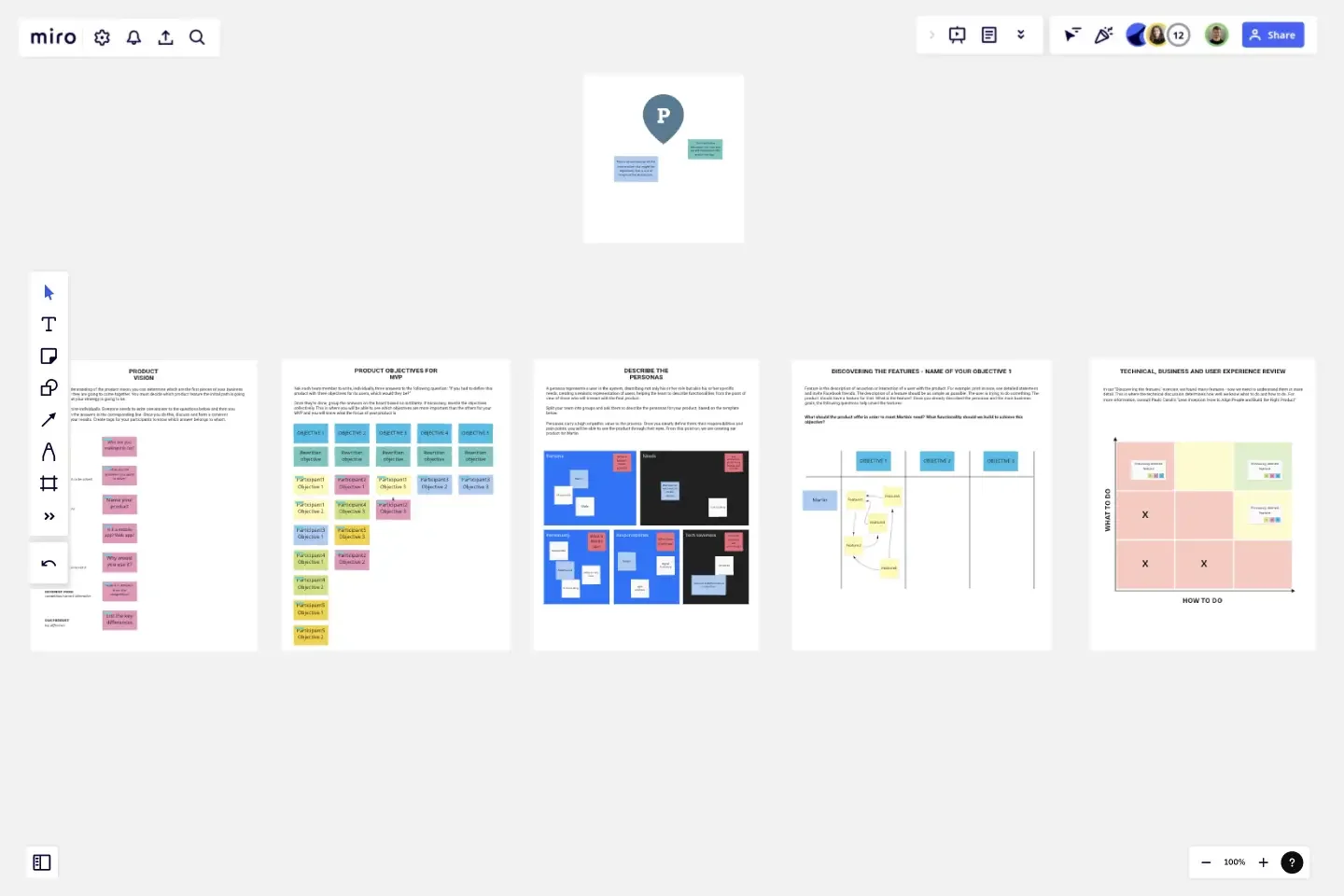Lean Inception
The Lean Inception method gives you a great place to start from - defining and developing an MVP.
Why use Lean Inception?
When we go into our workshops, we’re often faced with very little information and several stakeholders with different priorities and ideas about what needs to be done. It’s not possible to immediately make everyone happy, so our process helps us create a constructive dialogue between members of the same team who come into the workshop with different needs.
Through compromise and facilitated discussions, it gives us all a common goal to work towards and levels out everyone's expectations. This board is our interpretation of the Lean Inception approach and represents our learned experiences so far. We use it as a base and continue to modify it based on each workshop's needs. It helps us define the problem in the best possible way and get to a clearly defined MVP.
How is Lean Inception different from a Design Sprint?
We were interested in the problem-solving approach in the Design Sprint and the Lean Inception. The methodology was based on so much real experience from their creators that we wanted to give it a shot.
The Design Sprint method solves a different kind of issue than the Lean Inception one. The questions are different, as is the end result. As we went through them, we realized that the demands coming from our clients wouldn’t really fit either method - but a combination of both worked like a charm. Sometimes we also need to adapt the length of the workshop. We don't always have the 5 days both methodologies ask for - so we make it work in 3 days by cutting some of the activities. It's a bit more intense but works well both for our clients and us.
For example, we normally don't need to calculate the effort, time and cost - we try to go into the workshop with a ballpark figure regarding these estimates. However, this is an individual approach that works well for us, as we are in charge of both facilitating and developing the MVP in question.
The Lean Inception method gives you a great place to start from - defining and developing an MVP. This was most of what we needed to do. But in the end, it leaves you without a visual idea of what needs to be done. We feel that the visual representation of the problem being solved is like the cherry on top of a well defined MVP. That is where you can see that everyone is on the same page and you all understand the MVP properly. So we borrow the sketching part of the Design Sprint and incorporate it into our approach.
This template was created by RUBICON.
Get started with this template right now.
Burndown Chart Template
Works best for:
Project Management, Agile Workflows, Mapping
Whoa whoa whoa, pace yourself! That means knowing how much work is left—and, based on the delivery date, how much time you’ll have for each task. Perfect for project managers, Burndown Charts create a clear visualization of a team’s remaining work to help get it done on time and on budget. These charts have other big benefits, too. They encourage transparency and help individual team members be aware of their work pace so they can adjust or maintain it.
Backlog Refinement with Jira Template
Works best for:
Agile, Backlog Refinement
The Backlog Refinement with Jira template in Miro improves collaboration among team members. It provides a visual and interactive space for teams to review, prioritize, and clarify upcoming work items together in real time. This collaborative approach ensures alignment on priorities and details, leading to a more organized and efficient workflow. The seamless integration with Jira automatically syncs all changes, reducing the need for manual updates and keeping both platforms up-to-date.
OKR Drafting Board
Works best for:
Agile
The OKR Drafting Board (New) is a visual tool for defining and tracking Objectives and Key Results (OKRs). It provides a structured framework for setting ambitious goals, defining measurable outcomes, and aligning teams around shared objectives. This template enables organizations to articulate their strategic priorities, track progress transparently, and foster accountability and alignment across teams. By promoting focus, alignment, and agility, the OKR Drafting Board empowers organizations to achieve breakthrough results and drive continuous improvement.
Hiring Process Template
Works best for:
Operations, Org Charts, Kanban Boards
Having a hiring process in place simplifies that process each step of the way, from recruiting for the position to making finalizing offers. This simple, effective template will give you a straightforward, high-level view of where employees are as they move from applicant to new hire.
20/80 Process Diagram - EOS Compatible
Works best for:
Diagramming
The 20/80 Process Diagram - EOS® Compatible template is a visual tool for mapping out processes and workflows aligned with the Entrepreneurial Operating System (EOS®) methodology. It provides a structured framework for identifying core processes and key activities that drive business outcomes. This template enables organizations to streamline operations, clarify roles and responsibilities, and enhance accountability. By promoting alignment with EOS® principles, the 20/80 Process Diagram empowers teams to achieve organizational excellence and drive sustainable growth.
All-in-one PI Planning
Works best for:
Agile
The All-in-one PI Planning template streamlines the SAFe Program Increment (PI) Planning process by providing a comprehensive framework for teams to collaboratively plan and align on objectives and dependencies. It integrates essential elements such as PI Objectives, Team Breakouts, and Program Board, enabling teams to visualize, prioritize, and coordinate work effectively. This template empowers Agile Release Trains to deliver value predictably and efficiently, driving alignment and synchronization across the organization.
